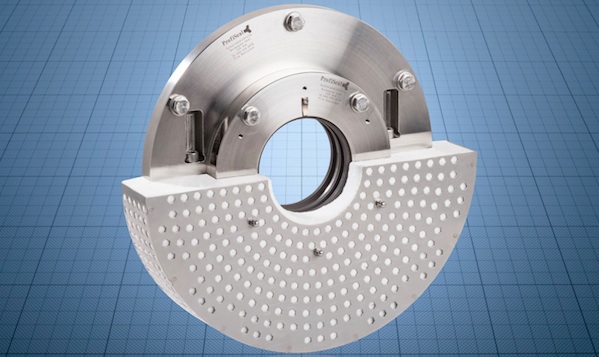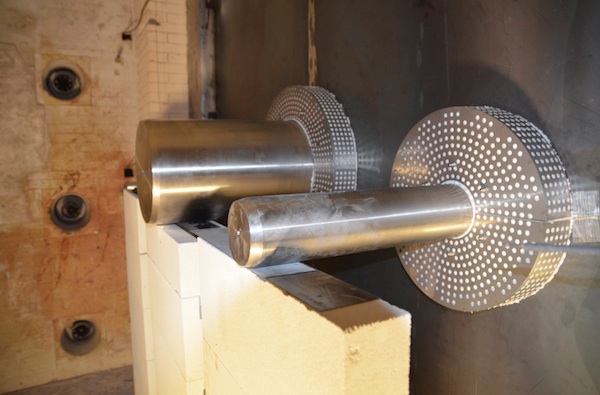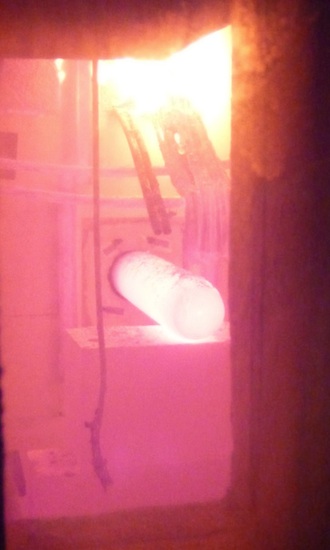Sealing the deal
ProfiSeal has developed a new bulkhead seal for drive shafts that prevents the spread of fire as well as the spread of water.…
ProfiSeal has launched its patented fireproof bulkhead seal for drive shafts. After successful water pressure testing, the seal demonstrated its resistance to fire for over an hour at 945oC.
In superyachting lay-terminology, bulkhead seals are recognised for the prevention of water spreading through a hull after a breaching collision. This understanding of bulkheads presents what is a rather limited view. Bulkhead seals may also be used to stop the spread of fire from the engine-room, and other high risk areas, to the yacht at large.
However, hitherto there have been few satisfactory structural solutions to replicate the conditions under which fire can be successfully contained without the need for additional fire protection systems beyond the bulkhead - especially within dynamic components such as rotating shafts. “Although A60 fire-resistant bulkhead seals, strictly speaking, have been regulated for a long time, technical approaches to a solution were previously costly and totally unsatisfactory”, explained a spokesperson for ProfiSeal.
ProfiSeal’s founder and owner, Hermann Aumüller, has devised a bulkhead seal capable of effectively stopping the structural proliferation of flames by adding a third sealing ring to his pre-established dual-ring, dry-running, split gap seals. The three rings are made from synthetic carbon without the addition of the PTFE plastics one would usually expect. These plastics, if used in a firefighting capacity, would dramatically reduce flame retardancy and diminish the consistency of the sealing rings when under heat stress.
When the outer ring comes into contact with fire at temperatures in excess of 500oC the carbon component begins to oxidise, releasing carbon dioxide and creating a barrier devoid of oxygen - a necessary component for combustion.
The outer ring is effectively “sacrificed”, Aumüller explains. “With this quasi-controlled combustion, carbon dioxide is released, which protects both sealing rings to the rear because the necessary oxygen for combustion is denied. The carbon itself can withstand temperatures of 1000 to 1200 degrees centigrade if there is no oxygen in the surrounding atmosphere.”
The additional ring is key because regardless of the assault direction there will still be a number of layers of defence. Once the first ring is fully oxidised the second ring will take up the defence and allow the third to continue preventing the spread of water - should the war be on two fronts.
Conclusive testing was carried out at the Institute for Safety Engineering in Freiberg, Germany. Using seal sizes from 50mm to 400 mm in shaft diameter, the bulkheads were tested with computer-controlled heats of up to 945oC - temperatures that brought the half-metre protruding shaft ends to a white heat. Various sensors were used to measure the temperature of the bulkheads on the flameless side; the tests showed that the temperature increase was limited to 180 degrees Kelvin, resulting in an overall temperature of 200oC - a temperature far bellow the 500 or 1200 degrees required to combust the synthetic carbon of the other sealing components.
"The fire trial for this type of bulkhead seal was also new for us at DNV GL", commented the engineer responsible for the test, Dr Dieter Krüger. "Any breach of the safety-related rules of the classification societies are now excluded." The draft for DNV GL approval has been drawn up and conclusive certification is expected immanently.
For more information click here
In superyachting lay-terminology, bulkhead seals are recognised for the prevention of water spreading through a hull after a breaching collision. This understanding of bulkheads presents what is a rather limited view. Bulkhead seals may also be used to stop the spread of fire from the engine-room, and other high risk areas, to the yacht at large.
However, hitherto there have been few satisfactory structural solutions to replicate the conditions under which fire can be successfully contained without the need for additional fire protection systems beyond the bulkhead - especially within dynamic components such as rotating shafts. “Although A60 fire-resistant bulkhead seals, strictly speaking, have been regulated for a long time, technical approaches to a solution were previously costly and totally unsatisfactory”, explained a spokesperson for ProfiSeal.
Bulkhead Seal
ProfiSeal’s founder and owner, Hermann Aumüller, has devised a bulkhead seal capable of effectively stopping the structural proliferation of flames by adding a third sealing ring to his pre-established dual-ring, dry-running, split gap seals. The three rings are made from synthetic carbon without the addition of the PTFE plastics one would usually expect. These plastics, if used in a firefighting capacity, would dramatically reduce flame retardancy and diminish the consistency of the sealing rings when under heat stress.
When the outer ring comes into contact with fire at temperatures in excess of 500oC the carbon component begins to oxidise, releasing carbon dioxide and creating a barrier devoid of oxygen - a necessary component for combustion.
The outer ring is effectively “sacrificed”, Aumüller explains. “With this quasi-controlled combustion, carbon dioxide is released, which protects both sealing rings to the rear because the necessary oxygen for combustion is denied. The carbon itself can withstand temperatures of 1000 to 1200 degrees centigrade if there is no oxygen in the surrounding atmosphere.”
The additional ring is key because regardless of the assault direction there will still be a number of layers of defence. Once the first ring is fully oxidised the second ring will take up the defence and allow the third to continue preventing the spread of water - should the war be on two fronts.
Different sizes ready for testing
Conclusive testing was carried out at the Institute for Safety Engineering in Freiberg, Germany. Using seal sizes from 50mm to 400 mm in shaft diameter, the bulkheads were tested with computer-controlled heats of up to 945oC - temperatures that brought the half-metre protruding shaft ends to a white heat. Various sensors were used to measure the temperature of the bulkheads on the flameless side; the tests showed that the temperature increase was limited to 180 degrees Kelvin, resulting in an overall temperature of 200oC - a temperature far bellow the 500 or 1200 degrees required to combust the synthetic carbon of the other sealing components.
White hot shaft end
"The fire trial for this type of bulkhead seal was also new for us at DNV GL", commented the engineer responsible for the test, Dr Dieter Krüger. "Any breach of the safety-related rules of the classification societies are now excluded." The draft for DNV GL approval has been drawn up and conclusive certification is expected immanently.
For more information click here
Profile links
Click here to become part of The Superyacht Group community, and join us in our mission to make this industry accessible to all, and prosperous for the long-term. We are offering access to the superyacht industry’s most comprehensive and longstanding archive of business-critical information, as well as a comprehensive, real-time superyacht fleet database, for just £10 per month, because we are One Industry with One Mission. Sign up here.






